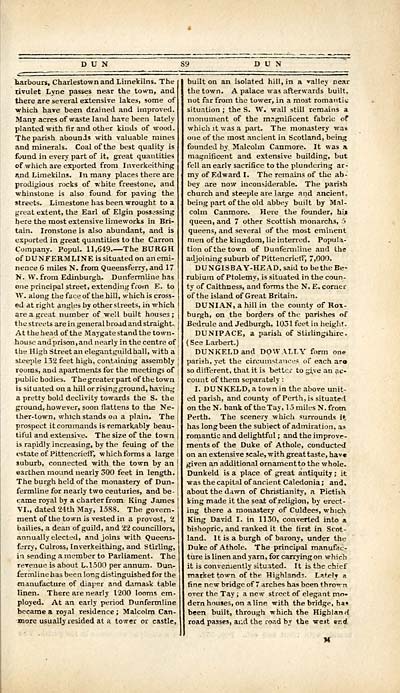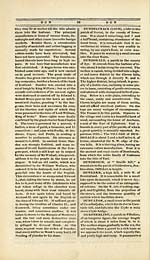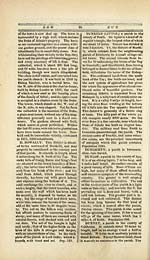Gazetteer of Scotland
(91) Page 89
Download files
Complete book:
Individual page:
Thumbnail gallery: Grid view | List view

DUN
DUN
harbours, Charlestown and Limekilns. The
rivulet Lyne passes near the town, and
there are several extensive lakes, some of
which have been drained and improved.
Many acres of waste land have been lately
planted with fir and other kinds of wood.
The parish abounds with valuable mines
and minerals. Coal of the best quality is
found in every part of it, great quantities
of which are exported from Inverkeithing
and Limekilns. In many places there are
prodigious rocks of white freestone, and
whinstone is also found for paving the
streets. Limestone has been wrought to a
great extent, the Earl of Elgin possessing
here the most extensive limeworks in Bri-
tain. Ironstone is also abundant, and is
exported in great quantities to the Carron
Company. Popul. 11,649. — The BURGH
of DUNFERMLINE is situated on an emi-
nence 6 miles N. from Queensferry, and 17
N. VV. from Edinburgh. Dunfermline has
one principal street, extending fiom E. to
W. along the face of the hill, which is cross-
ed at right angles by other streets, in which
are a great number of well built houses ;
the streets are in general broad and straight- j
At the head of the Margate stand the town-
house and prison, and nearly in the centre of j
the High Street an elegantguildhall, with a
steeple 132 feet high, containing assembly j
rooms, and apartments for the meetings of j
public bodies. The greater part of the town
is situated on a hill or rising ground, having
a pretty bold declivity towards the S. the
ground, however, soon flattens to the Ne- ;
ther-town, which stands on a plain. The
prospect it commands is remarkably beau-
tiful and extensive. The size of the town |
is rapidly increasing, by the feuing of the
estate of Pittencrieff, whichformsa large |
suburb, connected with the town by an j
earthen mound nearly 300 feet in length, i
The burgh held of the monastery of Dun-
fermline for nearly two centuries, and be- j
came royal by a charter from King James j
VI., dated 24th May, 1588. The govern-
ment of the town is vested in a provost, 2
bailies, a dean of guild, and 22 councillors,
annually elected, and joins with Queens- |
ferry, Culross, Inverkeithing, and Stirling,
in sending a member to Parliament. The
revenue is about L.1500 per annum. Dun-
fermline has been long distinguished for the
manufacture of diaper and damask table
linen. There are nearly 1200 looms em-
ployed. At an early period Dunfermline
became a royal residence ; Malcolm Can-
more usually resided at a tower or castle,
built on an isolated hill, in a valley near
the town. A palace was afterwards built,
not far from the tower, in a most romantic;
situation ; the S. W. wall still remains a
monument of the magnificent fabric of
which it was a part. The monastery was
one of the most ancient in Scotland, being
founded by Malcolm Canmore. It was a
magnificent and extensive building, but
fell an early sacrifice to the plundering ar-
my of Edward I. The remains of the ab-
bey are now inconsiderable. The parish
church and steeple are large and ancient,
being part of the old abbey built by Mal-
colm Canmore. Here the founder, hi.i
queen, and 7 other Scottish monarchs, 5
queens, and several of the most eminent
men of the kingdom, lie interred. Popula-
tion of the town of Dunfermline and the
adjoining suburb of PittencriefF, 7,000.
DUNGISB AY-HE AD, said to betheBe-
rubium of Ptolemy, is situated in the coun-
ty of Caithness, and forms the N. E. corner
of the island of Great Britain.
DUNIAN, a hill in the county of Rox-
burgh, on the borders of the parishes of
Bedrule and Jedburgh. 1031 feet in height.
DU NIP ACE, a parish of Stirlingshire.
(SeeLarbert.)
DUNKELD and DOWALLY form one
parish, yet the circumstances of each aro
so different, that it is better to give an ac-
count of them separately :
I. DUNKELD, a town in the above unit-
ed parish, and county of Perth, is situated
on the N. bank of the Tay , 1 5 miles N. from
Perth. The scenery which surrounds it
has long been the subject of admiration, as
romantic and delightful ; and the improve-
ments of the Duke of Athole, conducted
on an extensive scale, with great taste, hav«
given an additional ornament to the whole.
Dunkeld is a place of great antiquity ; it
was the capital of ancient Caledonia; and.
about the dawn of Christianity, a Pictish
king made it the seat of religion, by erect-
ing there a monastery of Culdees, which
King David I. in 1130, converted into a
bishopric, and ranked it the first in Scot-
land. It is a burgh of barony, under the
Duke of Athole. The principal manufac-
ture is linen and yarn, for carrying on which
it is conveniently situated. It is the chief
market town of the Highlands. Lately a
fine new bridge of 7 arches has been thrown
over the Tay ; a new street of elegant mo-
dern houses, on aline with the bridge, ha?
been built, through which the Highland
road passes, and the road by the west end
DUN
harbours, Charlestown and Limekilns. The
rivulet Lyne passes near the town, and
there are several extensive lakes, some of
which have been drained and improved.
Many acres of waste land have been lately
planted with fir and other kinds of wood.
The parish abounds with valuable mines
and minerals. Coal of the best quality is
found in every part of it, great quantities
of which are exported from Inverkeithing
and Limekilns. In many places there are
prodigious rocks of white freestone, and
whinstone is also found for paving the
streets. Limestone has been wrought to a
great extent, the Earl of Elgin possessing
here the most extensive limeworks in Bri-
tain. Ironstone is also abundant, and is
exported in great quantities to the Carron
Company. Popul. 11,649. — The BURGH
of DUNFERMLINE is situated on an emi-
nence 6 miles N. from Queensferry, and 17
N. VV. from Edinburgh. Dunfermline has
one principal street, extending fiom E. to
W. along the face of the hill, which is cross-
ed at right angles by other streets, in which
are a great number of well built houses ;
the streets are in general broad and straight- j
At the head of the Margate stand the town-
house and prison, and nearly in the centre of j
the High Street an elegantguildhall, with a
steeple 132 feet high, containing assembly j
rooms, and apartments for the meetings of j
public bodies. The greater part of the town
is situated on a hill or rising ground, having
a pretty bold declivity towards the S. the
ground, however, soon flattens to the Ne- ;
ther-town, which stands on a plain. The
prospect it commands is remarkably beau-
tiful and extensive. The size of the town |
is rapidly increasing, by the feuing of the
estate of Pittencrieff, whichformsa large |
suburb, connected with the town by an j
earthen mound nearly 300 feet in length, i
The burgh held of the monastery of Dun-
fermline for nearly two centuries, and be- j
came royal by a charter from King James j
VI., dated 24th May, 1588. The govern-
ment of the town is vested in a provost, 2
bailies, a dean of guild, and 22 councillors,
annually elected, and joins with Queens- |
ferry, Culross, Inverkeithing, and Stirling,
in sending a member to Parliament. The
revenue is about L.1500 per annum. Dun-
fermline has been long distinguished for the
manufacture of diaper and damask table
linen. There are nearly 1200 looms em-
ployed. At an early period Dunfermline
became a royal residence ; Malcolm Can-
more usually resided at a tower or castle,
built on an isolated hill, in a valley near
the town. A palace was afterwards built,
not far from the tower, in a most romantic;
situation ; the S. W. wall still remains a
monument of the magnificent fabric of
which it was a part. The monastery was
one of the most ancient in Scotland, being
founded by Malcolm Canmore. It was a
magnificent and extensive building, but
fell an early sacrifice to the plundering ar-
my of Edward I. The remains of the ab-
bey are now inconsiderable. The parish
church and steeple are large and ancient,
being part of the old abbey built by Mal-
colm Canmore. Here the founder, hi.i
queen, and 7 other Scottish monarchs, 5
queens, and several of the most eminent
men of the kingdom, lie interred. Popula-
tion of the town of Dunfermline and the
adjoining suburb of PittencriefF, 7,000.
DUNGISB AY-HE AD, said to betheBe-
rubium of Ptolemy, is situated in the coun-
ty of Caithness, and forms the N. E. corner
of the island of Great Britain.
DUNIAN, a hill in the county of Rox-
burgh, on the borders of the parishes of
Bedrule and Jedburgh. 1031 feet in height.
DU NIP ACE, a parish of Stirlingshire.
(SeeLarbert.)
DUNKELD and DOWALLY form one
parish, yet the circumstances of each aro
so different, that it is better to give an ac-
count of them separately :
I. DUNKELD, a town in the above unit-
ed parish, and county of Perth, is situated
on the N. bank of the Tay , 1 5 miles N. from
Perth. The scenery which surrounds it
has long been the subject of admiration, as
romantic and delightful ; and the improve-
ments of the Duke of Athole, conducted
on an extensive scale, with great taste, hav«
given an additional ornament to the whole.
Dunkeld is a place of great antiquity ; it
was the capital of ancient Caledonia; and.
about the dawn of Christianity, a Pictish
king made it the seat of religion, by erect-
ing there a monastery of Culdees, which
King David I. in 1130, converted into a
bishopric, and ranked it the first in Scot-
land. It is a burgh of barony, under the
Duke of Athole. The principal manufac-
ture is linen and yarn, for carrying on which
it is conveniently situated. It is the chief
market town of the Highlands. Lately a
fine new bridge of 7 arches has been thrown
over the Tay ; a new street of elegant mo-
dern houses, on aline with the bridge, ha?
been built, through which the Highland
road passes, and the road by the west end
Set display mode to: Large image | Transcription
Images and transcriptions on this page, including medium image downloads, may be used under the Creative Commons Attribution 4.0 International Licence unless otherwise stated. ![]()
| Gazetteers of Scotland, 1803-1901 > Gazetteer of Scotland > (91) Page 89 |
|---|
| Permanent URL | https://digital.nls.uk/97422786 |
|---|

